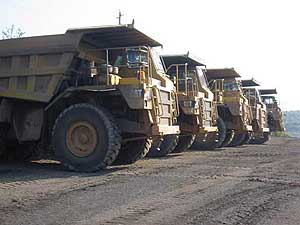|
Audio
Photos
More from MPR
Resources
Your Voice
|
Welcome to the Copper Range
March 31, 2004
Minnesota's first viable non-ferrous metals mine might be up and running in just three years. Several companies are eyeing Northeast Minnesota's deposits of nickel, copper, platinum and gold. Experts say the combined mining operations output could even surpass taconite as the state's leading mine export.
Duluth, Minn. — They call Northeast Minnesota the Iron Range. But iron may have to share top billing with other metals soon. The Range's ancient rock contains copper, nickel, gold, silver, platinum and palladium. New methods have been developed to coax precious metals from the hard rock - and to do so with minimal environmental effects.
Warren Huddelson is Minnesota's point man for PolyMet - a Vancouver, British Columbia based minerals company. PolyMet holds an option to crush rock in the former LTV taconite plant near Hoyt Lakes. He says a non-ferrous mining operation could be running very soon.
"This summer we intend to begin that process of permitting here in the state of Minnesota," Huddelson says. "And simultaneously we'll be doing the mine design and all the on site work that's required to develop a full blown commercial operation. So this is far from hypothetical. This we hope will be reality in a 3-to-5 year period."
The company's investment would be massive - around a quarter of a billion dollars.
"At 25,000 tons per day production, we'd be looking at employing in excess 400 people on a continuous basis, with more over time as production ratchets up," says Huddelson. "And the construction impacts on the front end would be significant too."
By volume, the new ventures will mostly turn out copper. But there will also be sizeable quantities of nickel. The precious metals - gold, silver, platinum, palladium and others - will be found in smaller quantities.
PolyMet is likely to be first non-ferrous metals operation, but it may not be the largest.
Another Vancouver based company, Teck Cominco, has plans on a much larger scale. But Teck Cominco is going to enter the market a little more slowly, according to Project Manager John Key. Key says the company's technology will first get a test in a new plant they're building in Brazil.
"Really, what we're trying to learn is how to scale these plants up successfully, so that when ever we turn them on, they operate at day one, instead of having to take them back down, and not being able to get them up for six months or a year," says Key.
|
The value of the product would be ... in the order of magnitude of $700 million a year, which starts to approach the order of magnitude of the taconite industry
- Ernie Lehmann, President of the Minnesota Exploration Association |
Teck Cominco is looking at a new production plant to be built in Babbitt, with construction possibly beginning in five years.
Meanwhile, Minnesota's Ernie Lehmann is planning a third, but smaller operation - an underground mine - based in the Birch Lake region near Babbitt. Lehmann is President of the Minnesota Exploration Association. He says, between the three leading projects, the state's non-ferrous metal mining could rival iron.
"If all three projects that we're currently talking about go, the total tons of ore processed would actually be right about the same level, order of magnitude as the tons of taconite pellets produced," Lehmann says. "That is around 35-to-40 million tons a year."
And the value of the metals mined will be similar to that of the taconite industry's.
"The value of the product would be, at fairly reasonable price projections, somewhere around, you know, in the order of magnitude of $700 million a year, which starts to approach the order of magnitude of the taconite industry," says Lehmann.
None of the projects are a slam dunk. Investors will have to be convinced. And so will government regulators. Ann Foss, with the Minnesota Pollution Control Agency, says the metals are found in sulfuric rock. Exposing that rock to rainwater and air could create sulfuric acid.
And Foss says there's a potential problem with mercury, which is already known to pollute regional lakes.
"There's mercury naturally occuring in water up in that area, too, and then there's mercury in the ore," Foss says. "So, that combination means that mercury will have to be looked at in particular in the (waste) water."
Permit applications will trigger Environmental Impact Statements. The studies are intended to identify and remedy any environmental concerns. But, without unforseen roadblocks, Minnesota's non-ferrous metals industry should be on line within a few years.
|
News Headlines
|
Related Subjects
|

